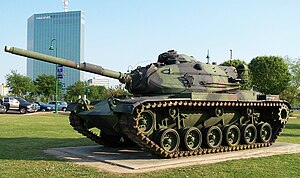M60 tank
| M60 Patton | |
|---|---|

An M60A3 Patton on display in Lake Charles, Louisiana, in April 2005.
|
|
| Type | Main battle tank |
| Place of origin | United States |
| Service history | |
| In service | 1961–present |
| Used by | See Operators |
| Wars |
Yom Kippur War Iran–Iraq War Beirut, Lebanon Invasion of Grenada Persian Gulf War Restore Hope, Somalia Western Sahara War Houthi insurgency in Yemen Turkey–PKK conflict Sinai insurgency Yemeni Civil War (2015)Saudi Arabian–led intervention in Yemen Syrian civil war |
| Production history | |
| Manufacturer | Detroit Arsenal Tank Plant, Chrysler |
| Produced | 1960–87 |
| Number built | Over 15,000 (all variants) |
| Variants | See Variants |
| Specifications | |
| Weight | M60: 50.7 short tons (46.0 t; 45.3 long tons) M60A1: 52 to 54 short tons (47 to 49 t; 46 to 48 long tons) depending on turret design. |
| Length | M60: 6.946 meters (22 ft 9.5 in) (hull), 9.309 meters (30 ft 6.5 in) (gun forward) |
| Width | M60: 3.631 meters (11 ft 11.0 in) |
| Height | M60: 3.213 meters (10 ft 6.5 in) |
| Crew | 4 |
|
|
|
| Armor |
Upper Glacis M60: 3.67 in (93 mm) at 65° 8.68 in (220 mm) LoS M60A1: 4.29 in (109 mm) at 65° 10.15 in (258 mm) LoS M60A2: same as M60A1 M60A3: same as M60A1 Turret Front M60: equals 7 in (180 mm) M60A1: equals 10 in (250 mm) M60A2: equals 11.5 in (290 mm) M60A3: same as M60A1 |
|
Main
armament |
105 mm (4.1 in) M68 gun (M60/A1/A3) 152 mm (6.0 in) M162 Gun/Launcher (M60A2) |
|
Secondary
armament |
.50 BMG (12.7×99mm) M85 7.62×51mm NATO M73 machine gun |
| Engine |
Continental AVDS-1790-2 V12, air-cooled Twin-turbo diesel engine 750 bhp (560 kW) |
| Power/weight | 15.08 bhp/st (12.4 kW/tonne) |
| Transmission | General Motors, cross-drive, single-stage with 2 forward and 1 reverse ranges |
| Suspension | Torsion bar suspension |
| Ground clearance | 1 foot 6.2 inches (0.463 m) |
| Fuel capacity | 385 U.S. gallons (1,457 L) |
|
Operational
range |
300 miles (500 km) |
| Speed | 30 mph (48 km/h) (road) |
The M60 Patton is a main battle tank (MBT) introduced in December 1960. With the United States Army's deactivation of their last (M103) heavy tank battalion in 1963, the M60 became the Army's primary tank during the Cold War. Although developed from the M48 Patton, the M60 series was never officially classified as a Patton tank, but as a "product-improved descendant" of the Patton series. In March 1959, the tank was officially standardized as the 105 mm Gun Full Tracked Combat Tank M60.
The M60 underwent many updates over its service life. The interior layout, based on the design of the M48, provided ample room for updates and improvements, extending the vehicle's service life for over four decades. It was widely used by the U.S. and its Cold War allies, especially those in NATO, and remains in service throughout the world today, despite having been superseded by the M1 Abrams in the U.S. military. Egypt is currently the largest operator with 1,716 upgraded M60A3s, Turkey is second with 866 upgraded units in service, and Israel is third with over 700 units of Israeli variants.
During the Hungarian Revolution of 1956, a Soviet T-54A medium tank was driven onto the grounds of the British embassy in Budapest by the Hungarians. After a brief examination of this tank's armor and 100 mm gun, British officials decided that their 20 pounder was apparently incapable of defeating it. There were also rumors of an even larger 115 mm gun in the works. Hence there was a need to adopt a 105 mm gun, which emerged as the famed Royal Ordnance L7. This information made its way to the United States, where the Army had been experimenting with a series of upgrades to their M48 Patton tanks. These experiments were concerned with improving the armor and the introduction of a variety of autoloader systems, such as that used in the 105 mm gun tank T54, and upgraded rangefinders.
...
Wikipedia
